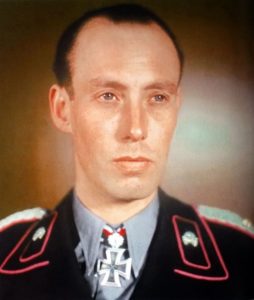Lauchert, Meinrad von, born 09-08-1905 in Potsdam  , entered on active Army service as a Fahnenjunker (Officer Cadet) on 01-04-1924, age 18. By the eve of World War II, he had advanced to the rank of Hauptmann and commanded the 2nd Company of the 35th Panzer Regiment. The first day of fighting in Poland brought his elevation to battalion commander after the previous commander, Hauptmann Stenglein, later a Major General, received a serious head wound
, entered on active Army service as a Fahnenjunker (Officer Cadet) on 01-04-1924, age 18. By the eve of World War II, he had advanced to the rank of Hauptmann and commanded the 2nd Company of the 35th Panzer Regiment. The first day of fighting in Poland brought his elevation to battalion commander after the previous commander, Hauptmann Stenglein, later a Major General, received a serious head wound  , a common injury for armor commanders. Lauchert served with the 35th Panzer Regiment of the 4th Panzer Division
, a common injury for armor commanders. Lauchert served with the 35th Panzer Regiment of the 4th Panzer Division  , under General der Panzertruppe, Dietrich von Saucken
, under General der Panzertruppe, Dietrich von Saucken

 throughout the Polish and French Campaigns. During the first drive into Russia in the summer of 1941, he earned the Knight’s Cross to the Iron Cross. Lauchert’s skill and energy as a Panzer leader caught the attention of such armor notables as Generaloberst Heinz Wilhelm Guderian
throughout the Polish and French Campaigns. During the first drive into Russia in the summer of 1941, he earned the Knight’s Cross to the Iron Cross. Lauchert’s skill and energy as a Panzer leader caught the attention of such armor notables as Generaloberst Heinz Wilhelm Guderian

 and General der Panzertruppe, Heinrich Eberbach
and General der Panzertruppe, Heinrich Eberbach

 . When Germany developed a new tank to regain its lost superiority on the battlefield, Major Lauchert was chosen to form and train the first two battalions of Panthers. Hitler ordered the delay of the 1943 summer offensive until Lauchert’s Panthers arrived to spearhead the southern arm of the attack. Unfortunately, the failure of the commanders whom Lauchert was supporting to familiarize themselves with this new weapon caused the Panther’s debut at the Battle of Kursk to be less than decisive. Lauchert continued to command a battle group of Panthers after Kursk, was promoted to Oberstleutnant and eventually was named as the commander of Panzer Regiment 15 of the 11th Panzer Division
. When Germany developed a new tank to regain its lost superiority on the battlefield, Major Lauchert was chosen to form and train the first two battalions of Panthers. Hitler ordered the delay of the 1943 summer offensive until Lauchert’s Panthers arrived to spearhead the southern arm of the attack. Unfortunately, the failure of the commanders whom Lauchert was supporting to familiarize themselves with this new weapon caused the Panther’s debut at the Battle of Kursk to be less than decisive. Lauchert continued to command a battle group of Panthers after Kursk, was promoted to Oberstleutnant and eventually was named as the commander of Panzer Regiment 15 of the 11th Panzer Division  under command of General der Panzertruppe Hermann Balck.
under command of General der Panzertruppe Hermann Balck. 
 While with this unit, he earned the Oak Leaves to his Knight’s Cross
While with this unit, he earned the Oak Leaves to his Knight’s Cross 
 In the summer of 1944, Lauchert was called upon to command Panzer Brigade 101
In the summer of 1944, Lauchert was called upon to command Panzer Brigade 101  , one of several new armored units hastily formed to restore the German Army’s precarious situation in the East. As part of Panzerverband Gemneral der Waffen SS, General Graf Hyacinth von Strachwitz
, one of several new armored units hastily formed to restore the German Army’s precarious situation in the East. As part of Panzerverband Gemneral der Waffen SS, General Graf Hyacinth von Strachwitz 
 and later as its commander, Lauchert helped restore the land connection between Army Groups North and Center. Just one day before the start of the Battle of Bulge, Oberst Lauchert was tasked with taking charge of the 2nd Panzer Division
and later as its commander, Lauchert helped restore the land connection between Army Groups North and Center. Just one day before the start of the Battle of Bulge, Oberst Lauchert was tasked with taking charge of the 2nd Panzer Division  succeeding Generalmajor Henning Schönfeld.
succeeding Generalmajor Henning Schönfeld.  His division punched through the American lines on 16-12-1944 and by the time the offensive had literally run out of gas Lauchert’s men had achieved the deepest penetration into Allied-held territory of any of the German formations. Afterwards, Lauchert’s division fought a continuous rearguard action against the US forces as they pushed him back across the German frontier. 2nd SS Panzer Division collected 20 Knight’s Crosses and 17 German Cross in Gold
His division punched through the American lines on 16-12-1944 and by the time the offensive had literally run out of gas Lauchert’s men had achieved the deepest penetration into Allied-held territory of any of the German formations. Afterwards, Lauchert’s division fought a continuous rearguard action against the US forces as they pushed him back across the German frontier. 2nd SS Panzer Division collected 20 Knight’s Crosses and 17 German Cross in Gold  during 111 weeks of combat, destroying 1.730 tanks and assault guns, for the loss of 500 panzers. The unit destroyed more than 3.000 enemy tanks in the course of its combat history, more than any other German field division. The division is infamous for the massacre of 642 French civilians in the village of Oradour-sur-Glane
during 111 weeks of combat, destroying 1.730 tanks and assault guns, for the loss of 500 panzers. The unit destroyed more than 3.000 enemy tanks in the course of its combat history, more than any other German field division. The division is infamous for the massacre of 642 French civilians in the village of Oradour-sur-Glane  on 10 June 1944 in the Limousin region. SS-Sturmbannführer, “ Das Reich Division”. Ordered the, Oradour-sur-Glane, massacre, Adolf Diekmann,
on 10 June 1944 in the Limousin region. SS-Sturmbannführer, “ Das Reich Division”. Ordered the, Oradour-sur-Glane, massacre, Adolf Diekmann,

 commander of the Ist Battalion, 4th SS Panzergrenadier Regiment, “Der Führer” that committed the massacre, claimed that it was a just retaliation due to partisan activity in nearby Tulle and the kidnapping of SS Sturmbannführer, Division Das Reich. “Oradour sur Glane “ Der Führer Battallion, Helmut Kämpfe,
commander of the Ist Battalion, 4th SS Panzergrenadier Regiment, “Der Führer” that committed the massacre, claimed that it was a just retaliation due to partisan activity in nearby Tulle and the kidnapping of SS Sturmbannführer, Division Das Reich. “Oradour sur Glane “ Der Führer Battallion, Helmut Kämpfe, 
 although the German authorities had already executed ninety-nine people in the Tulle murders, following the killing and maiming of some forty German soldiers in Tulle by the Maquis
although the German authorities had already executed ninety-nine people in the Tulle murders, following the killing and maiming of some forty German soldiers in Tulle by the Maquis  resistance movement. During the fighting in February and March 1945, the 2nd Panzer Division was bled white and ceased to exist as much more than a marker on the map. By the end of March, as the remnants of his Division were backed up against the Rhine without a secure crossing point, Generalmajor Lauchert
resistance movement. During the fighting in February and March 1945, the 2nd Panzer Division was bled white and ceased to exist as much more than a marker on the map. By the end of March, as the remnants of his Division were backed up against the Rhine without a secure crossing point, Generalmajor Lauchert  ordered a breakout eastwards in small groups. Lauchert swam the Rhine with a small number of his staff and, apparently fed up with the hopelessness of the situation, quit the war and walked home to Bamberg, the home garrison of the 35th Panzer Regiment.
ordered a breakout eastwards in small groups. Lauchert swam the Rhine with a small number of his staff and, apparently fed up with the hopelessness of the situation, quit the war and walked home to Bamberg, the home garrison of the 35th Panzer Regiment.Death and burial ground of Lauchert, Meinrad von.

 Von Lauchert landed in Allied captivity on 01-05-1945 and released in 1947 he retired in Stuttgart, where he at the age of 81 died on 04-11-1987. He is buried with his wife Hedwig, who died age 79, 2005, on the Cemetery Möhringen, a suburb of Stuttgart.
Von Lauchert landed in Allied captivity on 01-05-1945 and released in 1947 he retired in Stuttgart, where he at the age of 81 died on 04-11-1987. He is buried with his wife Hedwig, who died age 79, 2005, on the Cemetery Möhringen, a suburb of Stuttgart.
Message(s), tips or interesting graves for the webmaster: robhopmans@outlook.com


















Leave a Reply